|
|
 |

The UV system primarily consists of 4 parts.

(1)Light resources
Ultraviolet light used in UV process varies with the purpose
of process. The most suitable type for each purpose is listed
below.
| UV
lamp |
Application |
Wavelength |
| High-pressure mercury lamp |
Curing, drying and adhering |
365nm |
| Metal halide lamp |
Curing, drying and adhering |
365nm |
| Low-pressure mercury lamp for sterilizing |
Sterilizing |
254nm |
| Low-pressure mercury lamp for cleaning and reforming |
Cleaning and reforming |
185nm, 254nm |
| Excimer lamp |
Cleaning and reforming |
172nm |
Features of spectral energy distribution of various light
sources.


(2)Irradiation equipments
Irradiation equipment, consisting of reflector and cooling
device, could be designed to meet various purposes.
Shapes of reflectors
| Light-concentrating
type |
Parallel
light type |
| Applying
the focus point light |
Applying
the diffused light |
 |
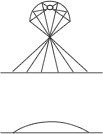 |
 |
| Cross
section is in elliptical shape. The high-intensity ultraviolet
lights will be generated when the focus point lights
are used, while the comparatively uniform ultraviolet
ones will be generated when the diffused rays are used. |
Cross section is paraboloid.
The ultraviolet lights could irradiate uniformly a wide
area of the object. |
Types of reflectors and the low temperature curing system
| Aluminum
mirror |
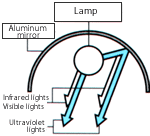 Ultraviolet
and heat lights are reflected effectively by using the
ultrapure aluminum reflector, which has the property
of high reflectivity. Ultraviolet
and heat lights are reflected effectively by using the
ultrapure aluminum reflector, which has the property
of high reflectivity. |
| Cold
mirror |
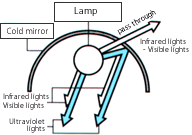 The
cold mirror is formed by coating a thin film of many
kinds ofmental compounds onto the designed glass substrate.
It can not only reflect the UV lights effectively, but
also transmit the visible lights and infrared lights
successfully, which are of nearly no use to UV curing. The
cold mirror is formed by coating a thin film of many
kinds ofmental compounds onto the designed glass substrate.
It can not only reflect the UV lights effectively, but
also transmit the visible lights and infrared lights
successfully, which are of nearly no use to UV curing. |
Cold
mirror
+
Cutoff filter of heat rays |
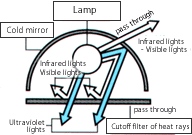 It
is necessary to use the cold mirror and the heat-ray
cutoff filter at the same time in the curing process,
which is proceeding at more lower temperature environment.
In this process, the necessary ultraviolet lights pass
through the heat-ray cutoff filter and the visible lights
are reflected there. It
is necessary to use the cold mirror and the heat-ray
cutoff filter at the same time in the curing process,
which is proceeding at more lower temperature environment.
In this process, the necessary ultraviolet lights pass
through the heat-ray cutoff filter and the visible lights
are reflected there. |
Cold
mirror
+
Ventilating
+
(Cutoff filter of heat rays) |
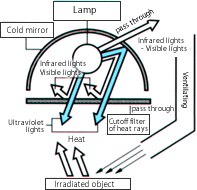 This
type is used in the process where the temperature should
be prevented from rising. In this process, the temperature
varies with the air volume and drops remarkably when
the heat-ray cutoff filter is added into use. This
type is used in the process where the temperature should
be prevented from rising. In this process, the temperature
varies with the air volume and drops remarkably when
the heat-ray cutoff filter is added into use. |

|
| ▲ |
 |
** About the ozone **
In UV process, the short wavelength ultraviolet rays are useful
but will generate the ozone. We proposed the following measures
to deal with the ozone problem.
(1)Standard lamp + exhaust system (outdoor)
(2)Ozoneless lamp (this measure is recommended when the outdoor
exhaust system could not be applied, though the efficiency
of dealing with the ozone is getting lower with it.)
[[Influence on the living bodies]]
The influences on living bodies caused by different ozone
densities are listed below.
| Ozone
density (ppm) |
Influences
on living bodies |
| 0.02
~ 0.05 |
There is a peculiar
smell. (Just a few seconds) |
| 0.06 |
No influences on the
ventilation function of the patients with chronic pulmonary
disease |
| 0.1
~ 0.3 |
Nose and throat are
irritated. (A few seconds ~ several tens of minutes)
The asthmatic patients are attacked by the disease more
frequently.
|
| 0.23 |
More people working
at the ozone-generating spot develop symptoms of chronic
bronchitis. (Exposed for several hours) |
| 0.6
~ 0.8 |
Symptoms of coughing
and difficult breathing are appeared. Furthermore, the
patient's ventilation function is becoming weaker. (2
hours) |
| 1
~ 2 |
Tiredness and headache
(1~2 hours) |
| 10 |
Difficulty in breathing,
pulmonary edema, and deep coma (several tens of minutes) |
| 15
~ 20 |
Existing the possibility
of death from pulmonary edema (in about 2 hours) |
| 1000ˆÈã |
In danger of death
in several minutes |
[[Environmental quality standard]]
▪Environmental quality standard:
Photochemical oxidant: no more than 0.06ppm per hour on average.
This value is changed to be about 0.05ppm if expressed with
ozone density.
▪Working environment standard (recommended permissible
limit):
The working environment standard is defined as a density,
under which there is no harmful influence on people's health
even people keep working 6 hours per day.
Japan: 0.1ppm or 0.2g/m3
USA: 0.1ppm
[[Reference]]
▪Sato: Photosensitivity, Tokyo Publish (1983) (Japanese)
▪Japan Association for Working Environment Measurement,
TLV of ACGIH chemical substance and environment factor (1990)
(Japanese)
▪Isao Mizoguchi: The toxicity and safety of ozone, ?
AR-77-4 (1977) (Japanese)
▪Public announcement No.47, Ministry of the Environment
(1973) (Japanese)
|
| ▲ |
| |
|